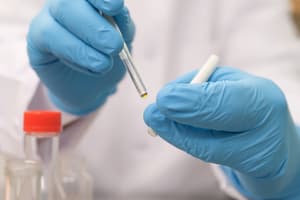Podcast
Questions and Answers
What is the primary purpose of forensic chemistry?
What is the primary purpose of forensic chemistry?
- To study the effects of drugs on the human body
- To analyze substances that may be misidentified (correct)
- To categorize different types of hair
- To examine physical evidence in violent crimes
Which of the following is considered a classification of explosives?
Which of the following is considered a classification of explosives?
- By their geographical origin
- By their toxic properties
- By chemical composition (correct)
- By their physical appearance
Why is hair considered valuable evidence in investigations?
Why is hair considered valuable evidence in investigations?
- Due to its unique physical characteristics (correct)
- Because it provides a definitive DNA profile
- Because it decomposes quickly after contact
- Due to its common presence in all environments
What characteristic of hair aids in its identification long after a crime?
What characteristic of hair aids in its identification long after a crime?
Which part of the hair is embedded in the skin?
Which part of the hair is embedded in the skin?
Which type of hair is generally categorized as long and stiff?
Which type of hair is generally categorized as long and stiff?
What does the term 'forensic' imply in the study of chemistry and toxicology?
What does the term 'forensic' imply in the study of chemistry and toxicology?
How does hair differ in terms of its shape?
How does hair differ in terms of its shape?
What is the primary characteristic of gallotannic ink?
What is the primary characteristic of gallotannic ink?
Which type of ink is known for smudging easily and being affected by moisture?
Which type of ink is known for smudging easily and being affected by moisture?
Which ink type is considered the oldest known material?
Which ink type is considered the oldest known material?
Which of the following inks is specifically composed of synthetic aniline dyestuffs?
Which of the following inks is specifically composed of synthetic aniline dyestuffs?
What common feature do loll logwood ink and gallotannic ink share?
What common feature do loll logwood ink and gallotannic ink share?
What is the primary chemical responsible for the color of hair?
What is the primary chemical responsible for the color of hair?
Which characteristic is NOT used to examine the condition of human hair?
Which characteristic is NOT used to examine the condition of human hair?
What does the Medullary Index indicate in hair analysis?
What does the Medullary Index indicate in hair analysis?
Under microscopic examination, dyed hair typically appears how compared to natural hair?
Under microscopic examination, dyed hair typically appears how compared to natural hair?
How can you determine whether hair is of human or animal origin based on the medulla?
How can you determine whether hair is of human or animal origin based on the medulla?
What characteristic is noted about the medulla in animal hair compared to human hair?
What characteristic is noted about the medulla in animal hair compared to human hair?
What is one characteristic of the hair cuticle examined during microscopic analysis?
What is one characteristic of the hair cuticle examined during microscopic analysis?
Which type of hair is typically more mature than other kinds of human hair?
Which type of hair is typically more mature than other kinds of human hair?
What characteristic distinguishes beard hair from other types of body hair?
What characteristic distinguishes beard hair from other types of body hair?
Which type of hair is described as having a fairly long length and unevenly distributed pigment?
Which type of hair is described as having a fairly long length and unevenly distributed pigment?
What is a distinguishing feature of pubic hair compared to auxiliary hair?
What is a distinguishing feature of pubic hair compared to auxiliary hair?
Which of the following tests is considered the most reliable for identifying fibers?
Which of the following tests is considered the most reliable for identifying fibers?
What is the main characteristic of infant hair as compared to adult hair?
What is the main characteristic of infant hair as compared to adult hair?
Which type of textile fiber can be natural or synthetic?
Which type of textile fiber can be natural or synthetic?
What testing method uses picric acid or iodine solution for fiber identification?
What testing method uses picric acid or iodine solution for fiber identification?
How can one determine that hair is from an adult compared to a child's hair?
How can one determine that hair is from an adult compared to a child's hair?
Which characteristic distinguishes wool from silk and vegetable fibers?
Which characteristic distinguishes wool from silk and vegetable fibers?
What is the primary purpose of the dissolution test outlined in the provided content?
What is the primary purpose of the dissolution test outlined in the provided content?
Which of the following fibers is described as having a jointed appearance resembling bamboo?
Which of the following fibers is described as having a jointed appearance resembling bamboo?
What is indicated by the presence of transverse folds or wrinkles in mercerized cotton?
What is indicated by the presence of transverse folds or wrinkles in mercerized cotton?
Which type of silk is characterized by its broader outline and fine longitudinal striations?
Which type of silk is characterized by its broader outline and fine longitudinal striations?
What method is used to ascertain the probable age and alterations of a document's paper?
What method is used to ascertain the probable age and alterations of a document's paper?
Which notable feature does artificial silk possess that distinguishes it from natural silks?
Which notable feature does artificial silk possess that distinguishes it from natural silks?
What is the essence of conducting a document examination?
What is the essence of conducting a document examination?
Flashcards are hidden until you start studying
Study Notes
Forensic Chemistry
- Forensic chemistry analyzes substances in criminal investigations
- Explosives are substances that decompose or combust suddenly
- Explosives are classified based on chemical composition and functioning characteristics
Hair and Textile Fibers
- Hair examination is a common forensic technique
- Hair is resistant to decomposition
- Human hair has distinctive characteristics based on location on the body
- Real hair is long and stiff while fuzz hair is short and fine
- Hair parts:
- Root: embedded in the skin
- Shaft: portion above the skin
- Tip: distal end of an uncut hair
- Microscopic hair analysis:
- Color: determined by melanin
- Length: measured using a ruler
- Width: measured using a microscope
- Tip: blunt, pointed, or frayed
- Root: intact or damaged
- Cuticle: size, shape, and regularity of scales are observed
- Cortex: embedded with pigment granules that provide color
- Dye: dyed hair has a dull appearance and constant color tone
- Curl: natural or artificially induced
- Medulla: the central core of the hair shaft
- Medullary Index: the ratio of medulla diameter to hair diameter
- Human hair vs. animal hair:
- Human hair: medullary index less than 0.5, medulla may be absent
- Animal hair: medullary index more than 0.5, medulla always present
- Region of the body:
- Scalp Hair: the most mature
- Beard Hair: coarse, curved, and stiff
- Eyebrow/Eyelid/Nose/Ear Hair: short, stubby, and wide medulla
- Trunk Hair: variable thickness, similar to scalp but finer and longer
- Limb Hair: similar to trunk hair, shorter and less coarse
- Auxiliary Hair: uneven pigment distribution, bleached appearance, sharp ends
- Pubic Hair: similar to axillary hair, coarse, wiry, continuous medulla, broken ends
- Age determination:
- Infants: fine, short hair, rudimentary pigment
- Children: finer and more immature hair than adults
- Adults: complete pigment development
- Grey/White: loss of pigment
- Body hair: less affected by age than scalp hair
Textile Fibers
- Fibers are converted into yarns
- Yarn: twisted fibers
- Fiber classification:
- Natural: cotton, linen, silk, wool
- Synthetic: artificial versions of natural fibers
- Fiber testing:
- Burning test: determines fiber type
- Fluorescence test: broad fiber classification
- Microscopic test: accurate identification
- Chemical test: identifies specific fibers
Questioned Documents
- Document: written or printed material whose authenticity is in question
- Document examination: involves comparing and analyzing paper and ink
- Paper examination:
- Age: determining the age of the document
- Alterations: detecting erasures, additions, or modifications
- Composition: identifying the components of the paper
Ink Analysis
- Ink analysis: determines the type, age, and origin of ink
- Ink types:
- Gallotannic (Iron) ink: iron salt and nutgall, penetrates paper fibers
- Logwood ink: logwood and potassium dichromate, inexpensive
- Negrosine (Aniline) ink: coal tar product, easily smudges and washes off
- Carbon (Chinese/India) ink: lampblack, does not penetrate deeply, easily washed off
- Colored writing ink: synthetic dyes dissolved in water
- Ballpoint ink: dyes soluble in glycol solvents
Studying That Suits You
Use AI to generate personalized quizzes and flashcards to suit your learning preferences.




